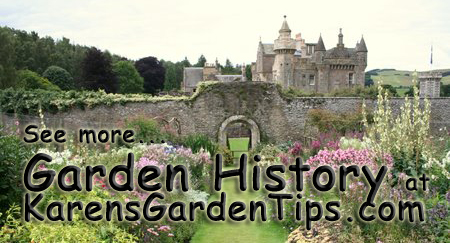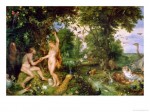 The Garden of Eden occupies a unique position in the history of gardens. Described in Genesis 2-3 of the Christian Bible, it is where God created man and woman, animals, and plants. Here, too, the serpent enticed Adam and Eve to eat the forbidden fruit and God cursed them and the serpent for their wrong doing and expels Adam and Eve. But what was the garden like? The Bible gives us some scant details and artists have supplied others.
The Garden of Eden occupies a unique position in the history of gardens. Described in Genesis 2-3 of the Christian Bible, it is where God created man and woman, animals, and plants. Here, too, the serpent enticed Adam and Eve to eat the forbidden fruit and God cursed them and the serpent for their wrong doing and expels Adam and Eve. But what was the garden like? The Bible gives us some scant details and artists have supplied others.
The Bible mentions the Garden of Eden is several places but Genesis 2-3 provides most of the information on the nature of the garden. From these verses we learn:
 The garden was located in the east, in Eden. Scholars do not agree on the nature or location of Eden or the garden.
The garden was located in the east, in Eden. Scholars do not agree on the nature or location of Eden or the garden.
 All kinds of trees were created in the garden; ones that were pleasant to look at as well as ones that provided fruit for food.
All kinds of trees were created in the garden; ones that were pleasant to look at as well as ones that provided fruit for food.

In the middle of the garden stood the Tree of Life and the Tree of Knowledge of Good and Evil.
 God put man in the garden He had created and told him to tend the garden but not eat the fruit from the Tree of Knowledge of Good and Evil.
God put man in the garden He had created and told him to tend the garden but not eat the fruit from the Tree of Knowledge of Good and Evil.
 The garden was watered by a river flowing from Eden that divided into four headwaters; the Pishon, Gihon, Tigris, and Euphrates.
The garden was watered by a river flowing from Eden that divided into four headwaters; the Pishon, Gihon, Tigris, and Euphrates.
 The garden was home to a large number of birds and animals, including snakes/serpents.
The garden was home to a large number of birds and animals, including snakes/serpents.
 Thorns and thistles became part of the garden after Adam and Eve ate the forbidden fruit.
Thorns and thistles became part of the garden after Adam and Eve ate the forbidden fruit.
It is interesting to note what is NOT mentioned in the Genesis account of the Garden of Eden. For example, we usually think that the fruit that was eaten was an apple although no mention is made of an apple. No flowers, ornaments, buildings or walls are mentioned either. Keeping this in mind, let’s take a look at some famous paintings that show the Garden of Eden.
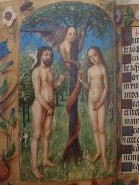 Warburg Hours (Flanders, end of the 15th century)
Warburg Hours (Flanders, end of the 15th century)
Adam and Eve stand on either side of a tree with round apple-like fruits and a serpent is entwined around its trunk. The lawn around them contains flowers and is bordered by trees. If a wall or water is present it is not visible in the picture.
The Grabow Alterpiece (Master Bertram of Minden, 1379-83)
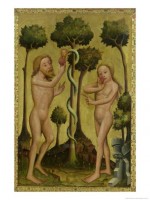 Adam and Eve stand in a cluster of pruned fruit bearing trees. One supports a snake in its branches. A hint of a wall is seen in the lower right and various flowering plants grow in the low ground cover beneath the trees.
Adam and Eve stand in a cluster of pruned fruit bearing trees. One supports a snake in its branches. A hint of a wall is seen in the lower right and various flowering plants grow in the low ground cover beneath the trees.
Boucicaut Master (The Story of Adam and Eve, 1415)
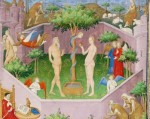 The Tree of Knowledge stands in the center of a walled garden. Eve is holding a fruit while the serpent and Adam look on. Yellow flowers and other pruned trees are shown in the garden as well as several other people.
The Tree of Knowledge stands in the center of a walled garden. Eve is holding a fruit while the serpent and Adam look on. Yellow flowers and other pruned trees are shown in the garden as well as several other people.
Michelangelo (Original Sin in the Sistine chapel, 1508-1512)
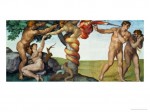 A very muscular Adam and Eve are fighting with a muscular serpent wound around the trunk of a tree with no visible fruit. A large rock formation is included but the lawn appears free of flowers.
A very muscular Adam and Eve are fighting with a muscular serpent wound around the trunk of a tree with no visible fruit. A large rock formation is included but the lawn appears free of flowers.
Lucas Cranach (Paradise, 1536)
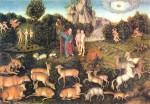 Animals abound in Cranach’s picture of the Garden of Eden. Adam and Eve are still to be seen in the background along with a fruit tree and shrubs bearing fruit and a large rock formation. Flowers are included in the grassy meadow.
Animals abound in Cranach’s picture of the Garden of Eden. Adam and Eve are still to be seen in the background along with a fruit tree and shrubs bearing fruit and a large rock formation. Flowers are included in the grassy meadow.
Hieronymus Bosh (The Garden of Earthly Delights, Creation of Eve, 1505-1515)
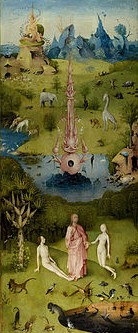 Birds fly through an edifice in the back left, water flows from a central fountain, numerous hut-like structures are scattered through the landscape, and animals of various sorts including rabbits play and strut though the grass. An elephant, giraffe, and cat are included as well as imaginary beasts. God appears to be introducing Eve to Adam who sits near a dragon tree, symbol of eternal life.
Birds fly through an edifice in the back left, water flows from a central fountain, numerous hut-like structures are scattered through the landscape, and animals of various sorts including rabbits play and strut though the grass. An elephant, giraffe, and cat are included as well as imaginary beasts. God appears to be introducing Eve to Adam who sits near a dragon tree, symbol of eternal life.
Thomas Cole (The Garden of Eden, 1828)
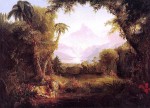 As founder of the Hudson River School known for its realistic and detailed portrayal of landscape, Cole presents a Garden of Eden with mature, lush vegetation and a mountain in the misty background. The vegetation and the vista are far more important than the tiny figures that can be made out in the background. The Tree of Knowledge of Good and Evil is indistinguishable from the other trees in the scene.
As founder of the Hudson River School known for its realistic and detailed portrayal of landscape, Cole presents a Garden of Eden with mature, lush vegetation and a mountain in the misty background. The vegetation and the vista are far more important than the tiny figures that can be made out in the background. The Tree of Knowledge of Good and Evil is indistinguishable from the other trees in the scene.
The Garden of Eden is a symbol for paradise and so takes on the attributes that society associates with a perfect place. Water, trees, animals, and Adam and Eve are included in the Biblical account but the garden could certainly have contained much more plant material and hardscape. Bosh even puts in fantastic creatures and plants.
